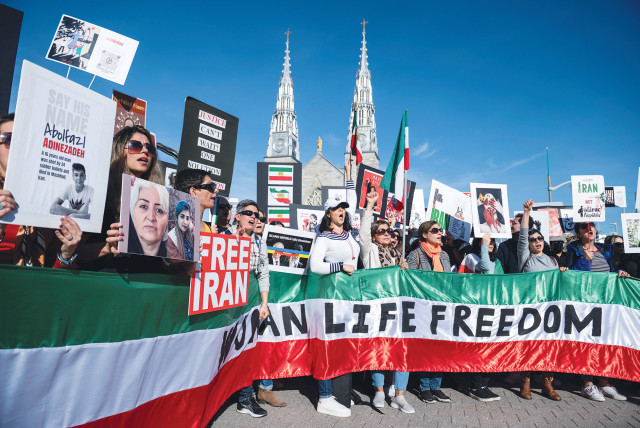Sexual violence within Islamic Republic of Iran is the regime's tool for control - opinion

Sexual violence in Iran serves a multifaceted role. At its core, it is a method of breaking down individuals’ defenses, paving the way for indoctrination and control.
The Islamic Republic of Iran (IRI) has insidiously and strategically employed sexual violence as an integral component of its governance and control mechanisms since its very inception.
This practice is not merely a manifestation of brutality but a calculated tool designed to consolidate political power, exert neo-colonial influence, and manipulate socioeconomic conditions. Understanding this grim reality is essential to grasping the profound implications of Iran’s tactics on its broader geopolitical ambitions.
Sexual violence in Iran serves a multifaceted role. At its core, it is a method of breaking down individuals’ defenses, paving the way for indoctrination and control.
This method of terror forms the backbone of the regime’s covert colonial project, a project that aims to extend its influence through the formation of the Shia Crescent.
As it absorbs large swathes of land into its Islamic revolutionary project, Iran leverages sexual violence to destabilize communities, fracture social bonds, and impose its ideological and political will.
Through terror – whether covert or overt, whether inferred or applied – the mullahs enforce stark compliance, where societal norms dictated by the regime are perpetuated through fear and subjugation, brutally stifling the emergence of opposition or even mere deviation from the prescribed order.
Since the Islamic Revolution in 1979, several Arab capitals have fallen under the yoke of the IRI. Tehran’s influence has expanded through a combination of military intervention, political manipulation, and the imposition of its ideological framework. For instance, in Beirut, Hezbollah’s grip tightened following IRI support during the Lebanese Civil War in the 1980s. In Baghdad, the IRI’s influence grew significantly after the US invasion of Iraq in 2003, leading to the establishment of numerous Iran-backed militias within the country. Similarly, in Damascus, the mullahs’ support for President Bashar al-Assad during the Syrian Civil War has been pivotal in maintaining the regime’s power. In Sana’a, the Houthi rebels, backed by the IRI, have controlled the capital since 2015, further demonstrating Tehran’s reach.
These interventions are not random acts of geopolitical maneuvering but part of a broader strategy of neo-colonial expansion. By destabilizing these regions through violence and terror, Iran ensures that the affected populations remain dependent and compliant.
The use of sexual violence within this framework is particularly insidious. It breaks down the psychological defenses of individuals, rendering them more susceptible to the regime’s indoctrination and control. This method of terror not only subjugates the individual but also fractures the social fabric of communities, making collective resistance against the regime’s influence increasingly difficult.
Iran’s neo-colonial project, characterized by the formation of the Shia Crescent, is a testament to this strategy. By embedding its ideological and political influence across a swath of territories, Tehran seeks to create a contiguous zone of control that extends its reach and consolidates its power.
Sexual violence, as a tool of terror and control, plays a critical role in this endeavor. It is through this brutal tactic that Tehran maintains its grip over both individuals and communities, ensuring their subjugation and compliance with the regime’s broader geopolitical objectives. It shatters the very fabric of an individual’s psychological and emotional being, with far-reaching consequences that extend well beyond the immediate aftermath of the traumatic event. The effects of such abuse are not confined to the initial victimization but often manifest in complex and multifaceted ways throughout the victim’s life. One particularly concerning consequence is the risk that victims might unconsciously replicate the trauma they endured, thereby perpetuating a cycle of abuse. This phenomenon is driven by the unconscious need to process and master the original trauma, leading victims to internalize the abuse and create a subconscious compulsion to recreate the trauma.
The impacts of such abuse
THE IMMEDIATE impact of sexual abuse is akin to a psychological earthquake, causing profound fragmentation within the victim’s psyche. This initial fracturing disrupts the victim’s sense of self, security, and trust in others, often inducing a state of hyperarousal, hypervigilance, and an overwhelming sense of helplessness. These responses, part of the body’s natural fight-or-flight mechanism, become maladaptive in the context of abuse, leading to long-term psychological distress.
The long-term consequences of sexual abuse are deeply rooted and multifarious.
Victims often struggle with chronic anxiety, depression, post-traumatic stress disorder (PTSD), and various other mental health issues. These conditions are not mere reactions to the trauma but represent profound alterations in the victim’s cognitive and emotional frameworks. The abuse essentially rewires the brain, creating neural pathways attuned to danger and distrust, fundamentally altering the victim’s interaction with the world.
One of the most insidious risks associated with the long-term effects of sexual abuse is the potential for victims to replicate the trauma they experienced. This replication can manifest in several ways, including abusive behavior toward others, dysfunctional relationships, and self-destructive patterns. Internal psychological mechanisms, learned behavior, and environmental factors all play critical roles in the replication of trauma. Victims of sexual abuse often grow up in environments where abuse is normalized or unaddressed, increasing the likelihood that they will perpetrate similar behaviors.
Moreover, economic exploitation is intricately linked with the regime’s use of sexual violence, manipulating dire economic conditions to coerce individuals, particularly women, into degrading circumstances that serve the dual purpose of boosting troop morale and securing the loyalty of the IRI’s military proxies.
The regime’s use of sexual violence extends to employing muta’a, or temporary marriages, manipulated to exploit young girls under the guise of legality and religious sanction. This practice starkly resembles sexual slavery and serves multiple strategic functions: binding the families of young girls to the regime through financial incentives, creating dependency loops, and reinforcing control over personal lives. The consequences are devastating, both in immediate harm and long-term social and psychological impacts.
A particularly sinister aspect of this practice is the fate of the children born from these unions, whether through coercion or outright violence. These children are often abandoned to orphanages controlled by the regime which are not sanctuaries of care but institutions of indoctrination and control.
In these state-run orphanages, children are systematically groomed to become loyal instruments of the regime’s ideological and military machinery. Devoid of familial or communal support systems that might offer alternative perspectives or resistance to the regime’s control, they are raised in environments where loyalty to the regime is paramount, and dissent is non-existent. From a very young age they are indoctrinated to revere its ideology, often being trained to serve in various capacities, including as child soldiers or operatives for the IRI’s military proxies.
This systemic abuse embeds the regime’s influence deeply within the fabric of society, extending its reach and control across generations.
By institutionalizing these children, the regime ensures their separation from any potential familial or communal support systems that could offer alternative perspectives or resistance to the regime’s control.
Addressing this issue requires a multifaceted approach. The international community must recognize sexual violence as not only a severe human rights abuse but also a deliberate strategy of political and social control. Robust international legal frameworks, targeted sanctions, and support for civil society movements are essential to dismantle the structures that perpetuate this cycle of violence.
By understanding and confronting this strategy as a form of neo-colonialism, the international community can take effective steps to prevent the exploitation of sexual violence as a geopolitical tool and support the sovereignty and dignity of vulnerable populations.
Arab capitals have a duty to recognize the insidious force that is eroding their sovereignty and the integrity of their traditions and history. This recognition is the first step in the battle to fight back and reclaim lost ground. By acknowledging the true nature of the threat, these nations can better mobilize their resources and galvanize their populations in the fight against the IRI’s influence.
This battle against the regime, both within and without, is fundamentally a battle for liberation. It is a fight for the liberation of the mind and the individual, as much as it is for the liberation of nations. By reclaiming their cultural heritage and asserting their autonomy, these nations can break free from the cycle of violence and subjugation imposed by the regime.
The struggle for liberation involves not only resisting external domination but also fostering an internal renaissance of cultural pride, social cohesion, and political agency.
The writer is executive director of the Forum for Foreign Relations and regional director at the American Center for Levant Studies.
Jerusalem Post Store
`; document.getElementById("linkPremium").innerHTML = cont; var divWithLink = document.getElementById("premium-link"); if (divWithLink !== null && divWithLink !== 'undefined') { divWithLink.style.border = "solid 1px #cb0f3e"; divWithLink.style.textAlign = "center"; divWithLink.style.marginBottom = "15px"; divWithLink.style.marginTop = "15px"; divWithLink.style.width = "100%"; divWithLink.style.backgroundColor = "#122952"; divWithLink.style.color = "#ffffff"; divWithLink.style.lineHeight = "1.5"; } } (function (v, i) { });

